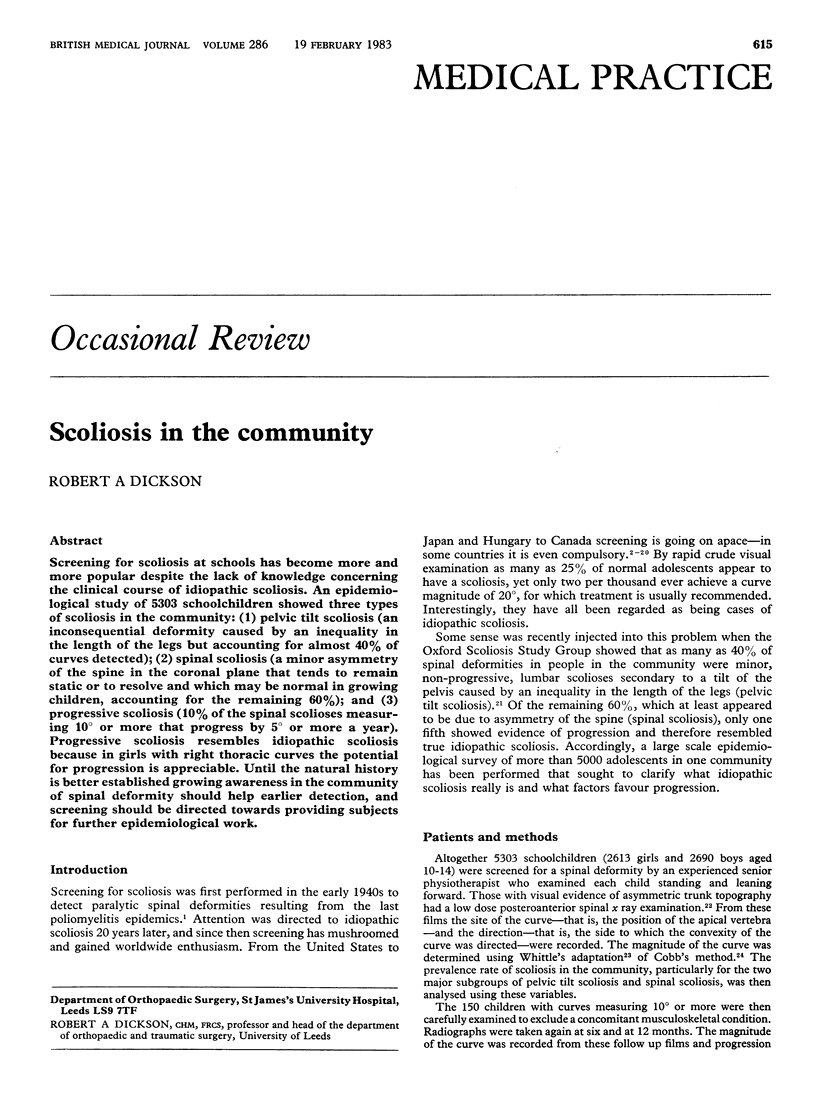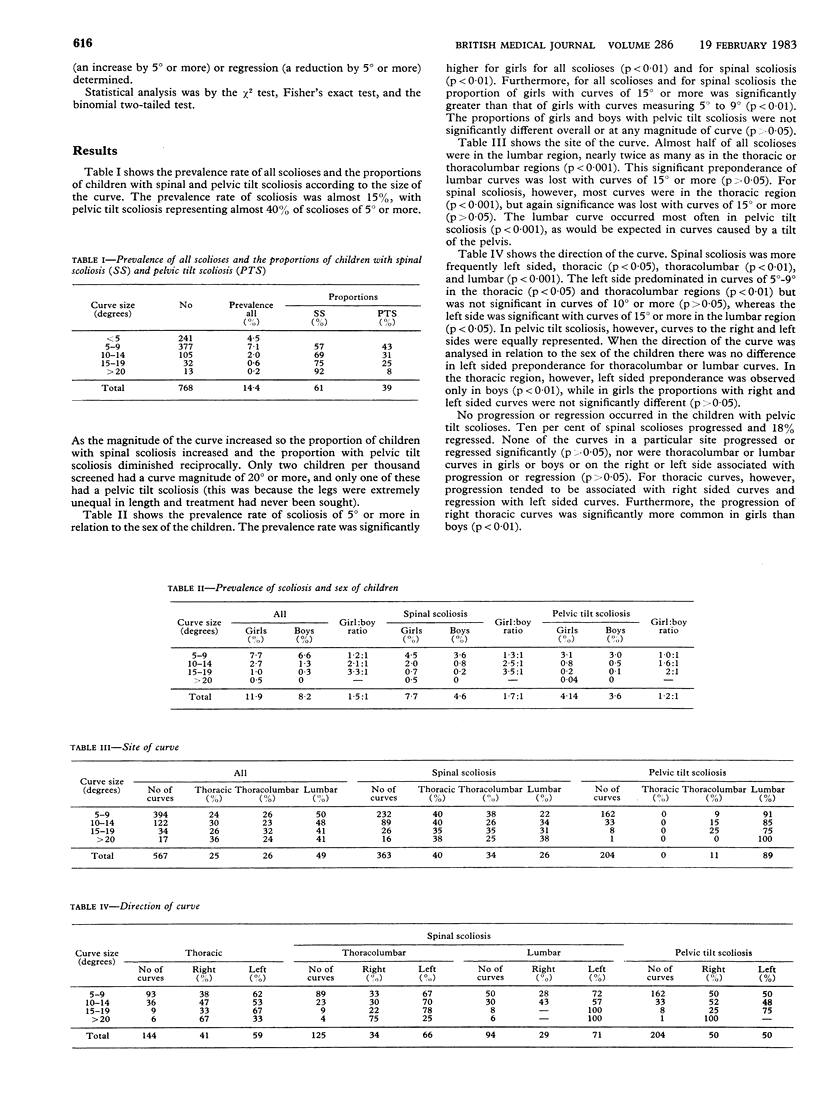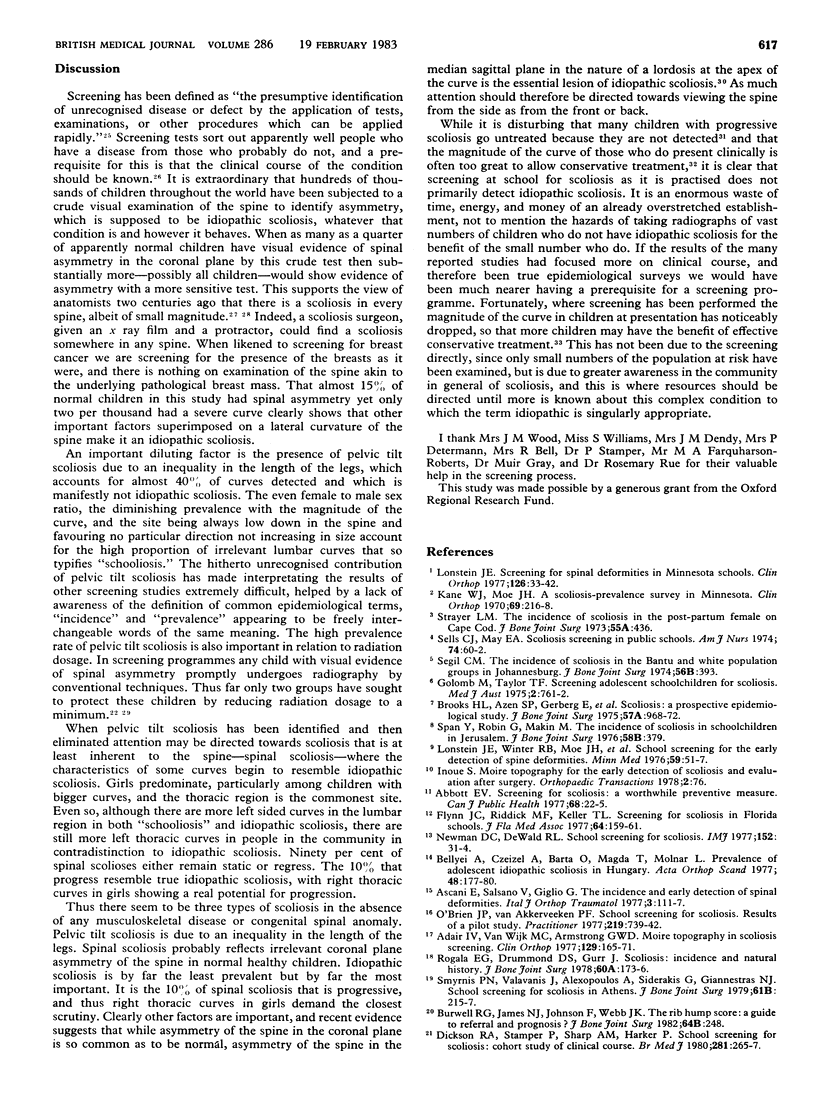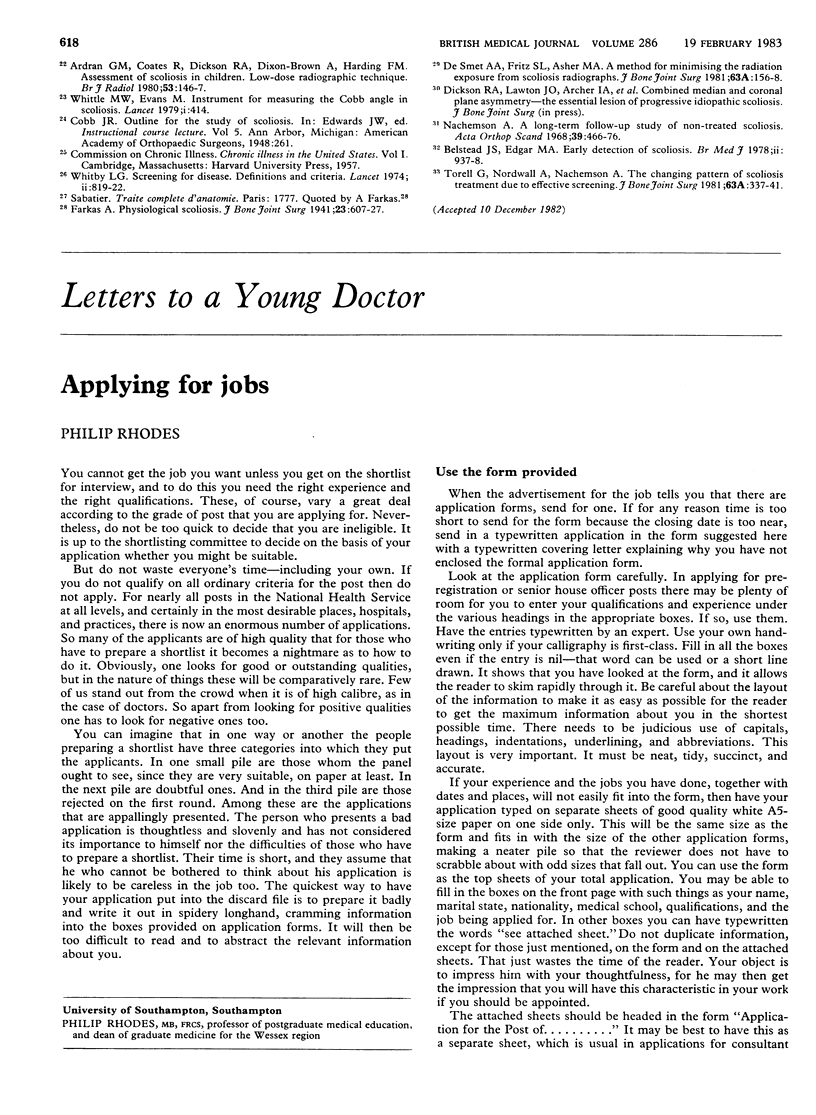Abstract
Screening for scoliosis at schools has become more and more popular despite the lack of knowledge concerning the clinical course of idiopathic scoliosis. An epidemiological study of 5303 schoolchildren showed three types of scoliosis in the community: (1) pelvic tilt scoliosis (an inconsequential deformity caused by an inequality in the length of the legs but accounting for almost 40% of curves detected); (2) spinal scoliosis (a minor asymmetry of the spine in the coronal plane that tends to remain static or to resolve and which may be normal in growing children, accounting for the remaining 60%); and (3) progressive scoliosis (10% of the spinal scolioses measuring 10 degrees or more that progress by 5 degrees or more a year). Progressive scoliosis resembles idiopathic scoliosis because in girls with right thoracic curves the potential for progression is appreciable. Until the natural history is better established growing awareness in the community of spinal deformity should help earlier detection, and screening should be directed towards providing subjects for further epidemiological work.
Full text
PDF



Selected References
These references are in PubMed. This may not be the complete list of references from this article.
- Abbott E. V. Screening for scoliosis: a worthwhile preventive measure. Can J Public Health. 1977 Jan-Feb;68(1):22–25. [PubMed] [Google Scholar]
- Adair I. V., Van Wijk M. C., Armstrong G. W. Moiré topography in scoliosis screening. Clin Orthop Relat Res. 1977 Nov-Dec;(129):165–171. doi: 10.1097/00003086-197711000-00019. [DOI] [PubMed] [Google Scholar]
- Ardran G. M., Coates R., Dickson R. A., Dixon-Brown A., Harding F. M. Assessment of scoliosis in children: low dose radiographic technique. Br J Radiol. 1980 Feb;53(626):146–147. doi: 10.1259/0007-1285-53-626-146. [DOI] [PubMed] [Google Scholar]
- Ascani E., Salsano V., Giglio G. The incidence and early detection of spinal deformities. A study based on the screening of 16,104 schoolchildren. Ital J Orthop Traumatol. 1977 Apr;3(1):111–117. [PubMed] [Google Scholar]
- Bellyei A., Czeizel A., Barta O., Magda T., Molnár L. Prevalence of adolescent idiopathic scoliosis in Hungary. Acta Orthop Scand. 1977;48(2):177–180. doi: 10.3109/17453677708985131. [DOI] [PubMed] [Google Scholar]
- Brooks H. L., Azen S. P., Gerberg E., Brooks R., Chan L. Scoliosis: A prospective epidemiological study. J Bone Joint Surg Am. 1975 Oct;57(7):968–972. [PubMed] [Google Scholar]
- De Smet A. A., Fritz S. L., Asher M. A. A method for minimizing the radiation exposure from scoliosis radiographs. J Bone Joint Surg Am. 1981 Jan;63(1):156–161. [PubMed] [Google Scholar]
- Dickson R. A., Stamper P., Sharp A. M., Harker P. School screening for scoliosis: cohort study of clinical course. Br Med J. 1980 Jul 26;281(6235):265–267. doi: 10.1136/bmj.281.6235.265. [DOI] [PMC free article] [PubMed] [Google Scholar]
- Flynn J. C., Riddick M. F., Keller T. L. Screening for scoliosis in Florida schools. J Fla Med Assoc. 1977 Mar;64(3):159–161. [PubMed] [Google Scholar]
- Golomb M., Taylor T. K. Letter: Screening adolescent school children for scoliosis. Med J Aust. 1975 Jun 14;1(24):761–762. [PubMed] [Google Scholar]
- Kane W. J., Moe J. H. A scoliosis-prevalence survey in Minnesota. Clin Orthop Relat Res. 1970 Mar-Apr;69:216–218. [PubMed] [Google Scholar]
- Lonstein J. E. Screening for spinal deformities in Minnesota schools. Clin Orthop Relat Res. 1977 Jul-Aug;(126):33–42. [PubMed] [Google Scholar]
- Lonstein J. E., Winter R. B., Moe J. H., Bianco A. J., Campbell R. G., Norval M. A. School screening for the early detection of spine deformities. Progress and pitfalls. Minn Med. 1976 Jan;59(1):51–57. [PubMed] [Google Scholar]
- Nachemson A. A long term follow-up study of non-treated scoliosis. Acta Orthop Scand. 1968;39(4):466–476. doi: 10.3109/17453676808989664. [DOI] [PubMed] [Google Scholar]
- O'Brien J. P., Van Akkerveeken P. F. School screening for scoliosis: results of a pilot study. Practitioner. 1977 Nov;219(1313):739–742. [PubMed] [Google Scholar]
- Rogala E. J., Drummond D. S., Gurr J. Scoliosis: incidence and natural history. A prospective epidemiological study. J Bone Joint Surg Am. 1978 Mar;60(2):173–176. [PubMed] [Google Scholar]
- Sells C. J., May E. A. Scoliosis screening in public schools. Am J Nurs. 1974 Jan;74(1):60–62. [PubMed] [Google Scholar]
- Smyrnis P. N., Valavanis J., Alexopoulos A., Siderakis G., Giannestras N. J. School screening for scoliosis in Athens. J Bone Joint Surg Br. 1979 May;61-B(2):215–217. doi: 10.1302/0301-620X.61B2.438274. [DOI] [PubMed] [Google Scholar]
- Torell G., Nordwall A., Nachemson A. The changing pattern of scoliosis treatment due to effective screening. J Bone Joint Surg Am. 1981 Mar;63(3):337–341. [PubMed] [Google Scholar]
- Whitby L. G. Screening for disease: Definitions and criteria. Lancet. 1974 Oct 5;2(7884):819–822. doi: 10.1016/s0140-6736(74)91082-4. [DOI] [PubMed] [Google Scholar]
- Whittle M. W., Evans M. Instrument for measuring the Cobb angle in scoliosis. Lancet. 1979 Feb 24;1(8113):414–414. doi: 10.1016/s0140-6736(79)90887-0. [DOI] [PubMed] [Google Scholar]


